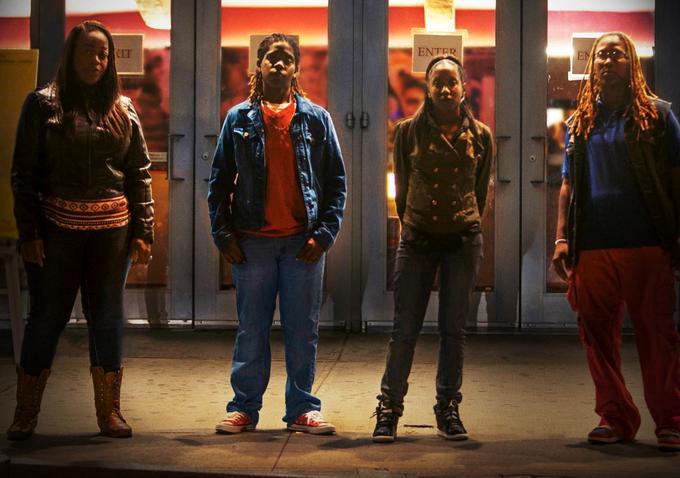In Newark, New Jersey, in May 2003, 19-year-old butch lesbian Sakia Gunn was stabbed to death after she politely turned down a sexual advance by an unknown man by telling him that she was a lesbian.
For lesbians, regardless of their feminine or masculine gender expression, there is always an undercurrent of cautious awareness that sits at the back of our minds as we move through public spaces. This is especially heightened for queer women of color.
The four women featured in the stunning new documentary, Out in the Night, were friends with Gunn and attended school with her. As queer women of color, they, too, personally experienced that lingering undercurrent stemming from potential harassment by men — men on the streets and men in uniform — as they simply try to live their lives.
Sixty percent of the approximately 2.3 million incarcerated in America are people of color. The number of incarcerated women has increased by 800% over the past three decades, with women of color three times more likely than white women to be incarcerated. Women’s incarceration rate is double that of men’s. Director blair dorosh-walther presents us with these statistics in Out in the Night, which chronicles the events of one night in the West Village in 2006, when a group of seven black lesbian women defended themselves and, consequently, were thrown into jail for protecting themselves and standing their ground.
The documentary follows the case of four of the “seething, sapphic septet,” as one female newspaper reporter called them, as they pleaded not guilty and went to trial over egregious charges of aggravated assault and even attempted murder of a 29-year-old black man, Dwayne Buckle, who verbally and physically assaulted the seven friends outside of the IFC theater in the West Village. Choking one and tearing a handful of braids out of another’s scalp, Buckle was tackled to the ground by two men who came to the aid of the women. These men, who left the scene after breaking up the fight, did not deter Buckle, who pursued the women down the street. One of the friends, Patreese Johnson, who was 19 at the time, was able to stave off Buckle’s continued assault by stabbing him with a pen-knife.
The girls were arrested later that night and taken to Rikers Island, a terrifying prison that would make Orange is the New Black’s Litchfield look like a palace. Hit with a number of charges, the young women, ranging in ages between 19 and 31, were told to plead guilty to have their sentences reduced to six months; three accepted the bargain, while the other four, refusing to acquiesce, went to court.
The case was a fiasco that culminated in the all-white jury convicting the “killer lesbian gang” to multi-year jail sentences, varying from 3.5 years to 11 years for Johnson. The white male judge patronizingly told them to recite their nursery rhymes — particularly “sticks and stones will break my bones, / but names will never hurt me” — while serving their time.
dorosh-walther weaves together a compelling narrative, not to prove the women’s innocence — which is evident by the myriad evidence, from the IFC’s security camera footage to the arresting officer explicitly stating there was no gang violence that night, to Buckle admitting that most of his injuries came at the hands of the two intervening men — but of how the justice system is actually constructed to work against protecting and serving women, and especially women of color who are gay and poor.
As dorosh-walther told Bitch Magazine that the case against the “New Jersey Four” was “a perfect storm of injustice,” and the documentary asks the extent to which women can defend themselves, especially when they need to defend themselves. “Self-defense,” she explains, “will never work if we’re not considering the entire context and what people have gone through… They’re no less black than they are lesbian, gender non-conforming, working class or poor. Their case is the perfect storm of injustice. But we need to figure out how to write about these intersectionalities.”
Out in the Night proves that documentary has become an important vehicle for telling stories for women, by women. When, and if, they are able to procure funding — which dorosh-walther achieved via a successful Kickstarter campaign and supplementary grants — minority, women and queer filmmakers are turning to this genre to tell their stories.
dorosh-walther gives these women justice. “Something positive came out of it,” Renata Hill, one of the four, said of the film. Justice is not only served by the fact that the film got made; it was primarily served in how it got made, and how these four women were able to talk for themselves, and how they were finally, even though it doesn’t change the past, able to stand their ground in the capacity that they were given rightful authority over their own story.
Previously: Human Rights Watch FF Director: Meet Blair Dorosh-Walther (Out in the Night)






